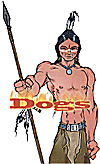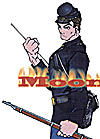
 Adapting the 2nd edition BROTHER AGAINST BROTHER (aka BAB) rules to fight skirmishes
and small battles of the Sioux Uprising in 1862 is not hard.
Adapting the 2nd edition BROTHER AGAINST BROTHER (aka BAB) rules to fight skirmishes
and small battles of the Sioux Uprising in 1862 is not hard.
Use all of the rules from the other periods' section of BAB, as well as all of the optional rules in BAB.
- Arm all Sioux with Muskets/Bows.
- All Army should have Rifles or Carbines.
- Civilians and Volunteers should be armed with Muskets or Shotguns.
The Minnesotans are simply the same troops as the Union Army fighting the Rebs. In fact, a good portion of the soldiers were indeed paroled prisoners of war. Indians are represented in the other periods' section of the rules. However, the Sioux at this time were different from the woodland Indians east of the Big Muddy, though this is not hard to correct either. Also, the terrain of the war offers a good variety of options.
In order to play the Sioux Uprising games using BAB, the rules at right should be considered.
A detailed history of the Sioux uprising of 1862 is too broad to discuss here. Save to say that in 1862, due to oversights by the U.S. government, a bad crop year, and general restlessness among certain tribal leaders of Sioux living in Minnesota, the frontier was set ablaze.
For several days in September the Sioux rampaged throughout southern and portions of western Minnesota. Causing great carnage and wide spread panic among the white settlers in the region. Unchecked the Indians forced refugees to flee to nearby forts and towns, which were then besieged by the Sioux.
In answer to the cries for help, the Government diverted several units slated to go south to fight the Rebs and sent them to bring the Sioux under control. At a snails pace the politically-appointed commander, Col. Sibley, set out from St. Paul and into southern Minnesota. The people came to call Sibley's small army the "Grave Diggers" due either to Sibley's cautious funeral procession pace, or because all along the route of march they had to bury the dead left by the Sioux.
 Within the drama of the Sioux Uprising, there
are many opportunities for small action games. All
1862 Uprising games should be Sioux ambushes or
Sioux attacking fortified Minnesotans. The very
largest battles only involved around a thousand
men on either side. Most engagements were fought
by little over a company. Besieged Minnesotans
could be behind anything from a few rifle pits to a
full-blown log stockade fort.
Within the drama of the Sioux Uprising, there
are many opportunities for small action games. All
1862 Uprising games should be Sioux ambushes or
Sioux attacking fortified Minnesotans. The very
largest battles only involved around a thousand
men on either side. Most engagements were fought
by little over a company. Besieged Minnesotans
could be behind anything from a few rifle pits to a
full-blown log stockade fort.
One of the best aspects of gaming the Uprising is that it allows some nice troop variations. There are Indians, Civilians, and a whole array of Army troop types. The Minnesotans had regular Volunteer Infantry, Civilian Volunteers, Volunteer Rangers, both Civilian and enlisted Cavalry and Artillery, Indian and mixed blood scouts, green troops and veterans, and untrained civilian settlers. All of these can be mixed on the Minnesotan side. Although the number of Indians and mixed bloods who fought with the Army was very small. Also, Artillery only figured in one or two of the many battles.
It is important to remember that the Sioux in Minnesota were more wood land types than the Sioux out west. This means that the number of mounted men in battle will be very small. The battles were fought, for the most part, on foot on both sides.
Another nice aspect of playing the Uprising is the land. The battles and skirmishes of the war were fought on a very wide variety of terrain. Everything from heavy woods to open prairie, and flat, featureless plowed fields to rugged rolling hills. The region is known as the "land of 10,000 lakes" and lakes figured in more than one or two fights (How often do you get to play a game on a lake shore?) Creeks and rivers did too. Those that like urban scenes are in luck too. Twice the Sioux warriors tried to take the fairly large town of New Ulm.
BROTHER AGAINST BROTHER is perfect to use for the Great Sioux Uprising of 1862. The fights were small and translate well to the scale of the BAB rules. The troop types engaged were varied and diverse. Minnesota's terrain allows for a good variety of potential battlefields for a good variety of potential battlefields.
Finally, the Sioux Uprising of '62 offers a good alternative for the American Civil War gamer to typical battles of the period.
Back to The Zouave Number 49 Table of Contents
Back to The Zouave List of Issues
Back to Master Magazine List
© Copyright 1999 The American Civil War Society
This article appears in MagWeb (Magazine Web) on the Internet World Wide Web.
Other military history articles and gaming articles are available at http://www.magweb.com